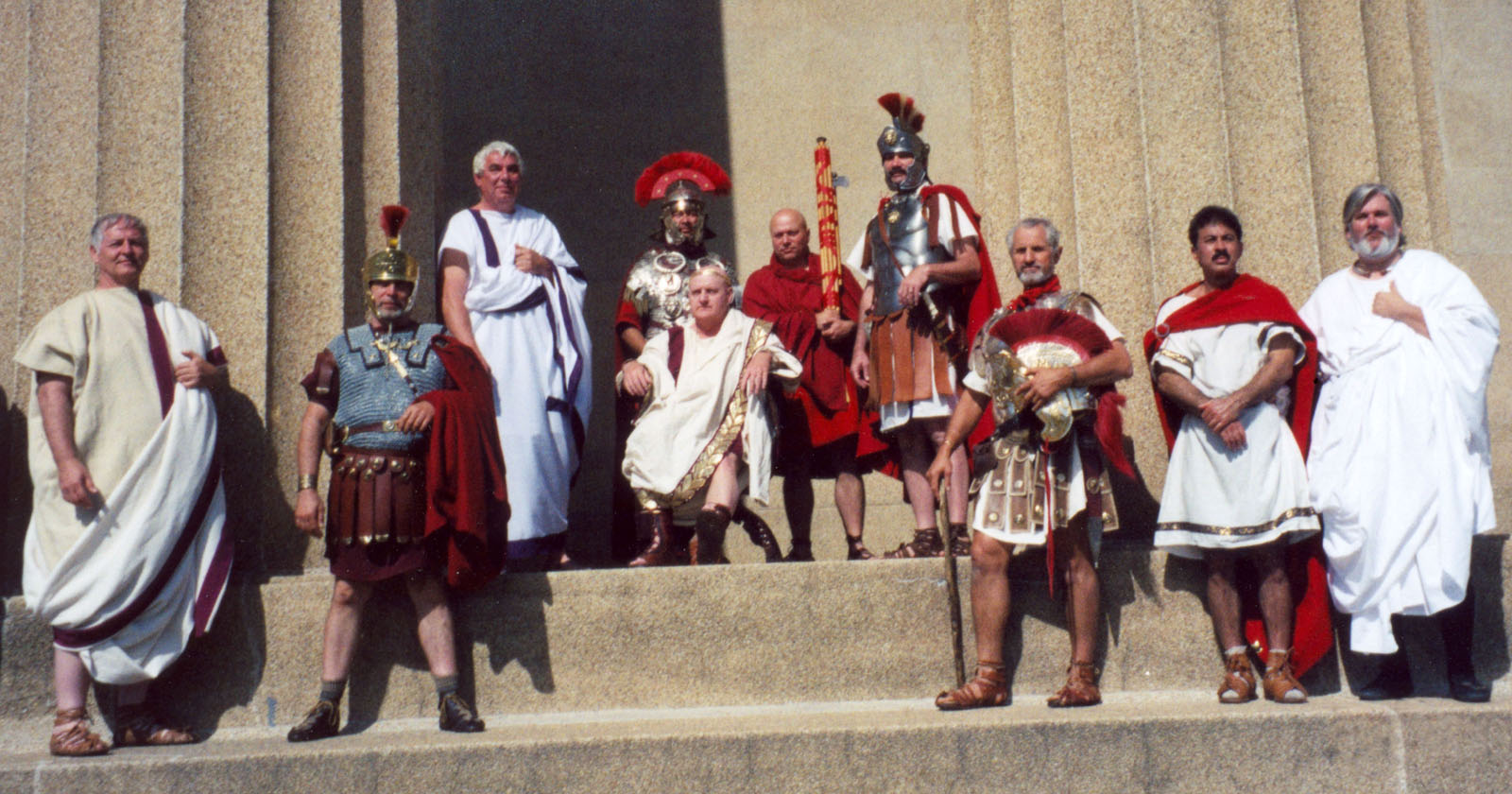 |
 |
 |
| Mission Statement Legio XXX Ulpia Victrix is a Roman reenactment group with members in Southern Ontario and Indiana. It was established in 2004 with the goal of portraying all aspects of Roman civilian and legionary life. Family participation is encouraged. |
| The Emperor Trajan (Marcus Ulpius Traianus) Trajan reigned as emperor from 98 to 117 A.D. He was born September 18th, 53 into the Ulpii family in the Baetican city of Italica (southern Spain), and he traced his ancestry there back to the 3rd Century B.C. His father, a Roman senator who served under Vespasianus as the legate of Legio X Fretensis, subsequently held several governorships including those of Baetica and Syria before becoming proconsul of Asia. He passed away before 100 A.D. and was deified in 113 A.D. Trajan served as a legate under his father in Syria, and then became a quaestor and a praetor before 84. He was a guardian of Hadrian in 86 and was subsequently appointed as the legate of Legio VII Gemina. He led his men against the rebel Antonius Saturninus on the Rhine and then fought under Domitian against the Germans. In 91 he became a consul and thereafter was the governor of Moesia inferior and then Germania superior. In 97, while still in Germania, Hadrian advised him that the emperor Nerva had adopted him as his heir. Trajan assumed power on January 27th, 98 when Nerva died. Trajan established the Limes while in Germany and entered into negotiations with the Dacian king Decebalus. Around 100 he began the preparations for his first Danube campaign. He ordered the redeployment of legions from several provinces including Germany and Britain, the transfer of auxiliary units into the area and the creation of two new legions to replace those that had been lost in battle. Legio XXX likely took the place of V Alaudae, which was crushed by the Sarmatians in 92, and Legio II Traiana replaced the vanquished Legio Rapax. The offensive was launched in 101 after the completion of a new road through the Iron Gates and the erection of a 60 arch bridge across the Danube. Although Decebalus capitulated in 102, he continued to harass the Romans and incite rebellions. Trajan returned to Dacia in 106 and engaged in a long bitter struggle that involved almost one third of the Roman army and concluded with Decebalus' suicide. The surviving Dacians were slain or enslaved, and the new Roman province of Dacia swelled with immigrants from other parts of the empire. The spoils of war translated into a massive public works program throughout the empire, and the victory was commemorated on Trajan's column. In 114 Trajan attacked Parthia and captured Babylon and Ctesiphon. The conquered areas were difficult to control and Trajan reluctantly withdrew to the west in 117 A.D. where he died in Selinus on August 9th. Hadrian was his successor. XXX U(lpia) V(ictrix) p(ia) f(idelis) Founded around 100 A.D., Legio XXX earned the cognomen Victrix (winner) for its involvement in the Dacian conflict. It was stationed at Brigetio (Szony) in Pannonia Superior in 105 after XI Claudia was transferred to Oescus (in Lower Moesia). Stamped tiles discovered at Carnutum and Vindobona testify to Legio XXX's presence there involved in construction projects, which makes participation in Trajan's Parthian war of 114-117 unlikely. In 118 Marcius Turbo was given the task of quelling unrest in Pannonia and Dacia following Trajan's death, and he would have been Legio XXX's supreme commander. When VI Victrix was redeployed to Britain in 119-122 Legio XXX occupied its former base at Castra Vetera near Colonia Ulpia Traiana (Xanten) in Germania Inferior. The fort was strategically placed where the Lippe joins the Rhine making it ideally suited to control the area and launch raids into Germany. Soldiers from the XXXth are found posted in Colonia Ara Agrippinensium (Cologne) as clerks in the office of the governor of Germania Inferior, running lime kilns at Iversheim, involved in construction in Bonna (Bonn) along with Legio I Minervia, and serving in locations such as Rigomagus (Remagen), Noviomagus and Divitia. Detachments were posted in Gaul and Legio XXX's name has been associated with Cabillonum (Chalon Saone-et-Loire), Lugudunum (Lyon), Lutetia (Paris) and Avaricium (Bourges). A vexillation of Legio XXXth may have accompanied I Minervia when it participated in Lucius Verus' Parthian campaign in 162. It supported Lucius Septimius Severus against Clodius Albinus in 196/197 and earned the title Pia Fidelis (faithful and loyal). Vexillations of XXX served with Iulius Castinus in 206-8 when he quelled dissident Gauls and Spaniards and fought with Severus in Britannia. Detachments were active with Severus Alexander in Persia in 235. The lower Rhine was overrun in 240 and then again in 256. Postumus repelled the invaders in 260, established in-depth defences and founded the Gallic Empire with the support of Legio XXX. Aurelian's reintegration of Gaul into the Roman Empire in 274 was accomplished at a significant loss in life, and the Franks overran the weakened defences as far as Paris. Order was firmly restored by Chlorus around 300, and he refounded Colonia Ulpia Traiana (Xanten), which had been a ghost town for almost a quarter of a century. Legio XXX was transferred into the city, which was henceforth known as Tricesimae (thirty). According to Ammianus Marecllinus "soldiers of the Thirtieth"were present at Amida when the Persians laid siege to and captured the city in 359 AD. The men who served in Legio XXX originated from such diverse places as Italia, Germania Inferior, Gallia, Belgica, Britannia, Dalmatia and Thracia. Examination of the coinage of Gallienus suggests a relationship between the legion and the god Neptune, while those of Victorinus link the god Jupiter, and the astrological sign of Capricorn, with the XXXth. Names of Officers and Men Legati Legionis L. Aemilius L. f. Cam(ilia) Karus, legate at the end of Hadrian;s era, Canutius Modestus, in the year 223, C. Iulius C. f. Fabia Severus,C. Iulius CN. f. Verus, under Antoninus Pius around the year 148, Iunius Faustinus ...... Postumianus, third century, Q. Marcius Gallianus,Q. Petronius Melior, around the time of Severus Alexander. Tribuni militum Aelius Carus, third century, T. Caesarnius Quinctius Macedo Quinctianus, Hadrians era, T. Marius Martialis, third century, C. Sagurus C. f. Clu(stumina) Priscus, M. Rossius M. f. Pupinia Vitulus e(gregius) v(ir), T. Varius T. f. Clemens Cl(audia) Celia, in the time of Antoninus Pius. Praefecti T. Statilius ... f. Pollia ...in the year 129/130. Primi Ordines (First Order) L. Petronius Taurus Volusianus, T. Pontius M. f. Sept(imia?) Marcianus Carnunto, primipil(us), in the year 243. Centurions M. Annius M. f. Quir. Martialis, under Traian,Aur(elius) Tertins, third century, C. Caesius C. f. Ouf(entina) Silvester, in the time of Hadrian, T. Fl(avius) Constans, (centurio) protec(tor), T. Flavius Super,T. Flavius Victorinus, Q. Iulius C. f. Quir. Aquila, in the time of Hadrian or Antoninus Pius, M. Iulius Martius, in the year 189, C. Iulius Fab(ia) Procolus, Priscus, in the year 211, M. Petronius Fortunatus, L. Septimius L. f. Pannonius, d(omo) Ulp(ia) Papir(ia) Petavione Marcellinus, in the time of Severus Alexander, M. Verecundinius Simplex, in the year 164, Ulpius Charistus, third century. |
| Home |
| Legio XXX U(lpia) V(ictrix) p(ia) f(idelis) |
| To contact us please click on the following: Cornicularius Legionis |

|
| You are visiter number: |
| Legio XXX Ulpia Victrix - Background History |
| Last Site Updated: Friday June 5th, 2009 |
| The background picture is courtesy of the VRoma Image Archive. |